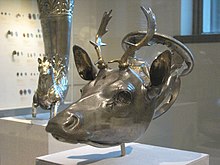Deer
Deer or true deer are hoofed ruminant mammals formings the family Cervidae.
In literature
Deer have been an integral part of fables and other literary works since the inception of writing. Stags were used as symbols in the latter Sumerian writings. For instance, the boat of Sumerian god Enki is named the Stag of Azbu. There are several mentions of the animal in the Rigveda as well as the Bible. In the Indian epic Ramayana, Sita is lured by a golden deer which Rama tries to catch. In the absence of both Rama and Lakshman, Ravana kidnaps Sita. Many of the allegorical Aesop's fables, such as "The Stag at the Pool", "The One-Eyed Doe" and "The Stag and a Lion", personify deer to give moral lessons. For instance, "The Sick Stag" gives the message that uncaring friends can do more harm than good.[87] The Yaqui deer song accompanies the deer dance which is performed by a pascola [from the Spanish 'pascua', Easter] dancer (also known as a deer dancer). Pascolas would perform at religious and social functions many times of the year, especially during Lent and Easter.[87][92]
In one of Rudolf Erich Raspe's 1785 stories of Baron Munchausen's Narrative of his Marvellous Travels and Campaigns in Russia, the baron encounters a stag while eating cherries and, without ammunition, fires the cherry-pits at the stag with his musket, but it escapes. The next year, the baron encounters a stag with a cherry tree growing from its head; presumably this is the animal he had shot at the previous year. In Christmas lore (such as in the narrative poem "A Visit from St. Nicholas"), reindeer are often depicted pulling the sleigh of Santa Claus.[93] Marjorie Kinnan Rawlings's Pulitzer Prize-winning 1938 novel The Yearling was about a boy's relationship with a baby deer. The fiction book Fire Bringer is about a young fawn who goes on a quest to save the Herla, the deer kind.[94] In the 1942 Walt Disney Pictures film, Bambi is a white-tailed deer, while in Felix Salten's original 1923 book Bambi, a Life in the Woods, he is a roe deer. In C. S. Lewis's 1950 fantasy novel The Lion, the Witch and the Wardrobe the adult Pevensies, now kings and queens of Narnia, chase the White Stag on a hunt, as the Stag is said to grant its captor a wish. The hunt is key in returning the Pevensies to their home in England. In the 1979 book The Animals of Farthing Wood, The Great White Stag is the leader of all the animals.- wikipedia
In history
Deer had a central role in the ancient art, culture and mythology of the Hittites, the ancient Egyptians, the Celts, the ancient Greeks, the Asians and several others. For instance, the Stag Hunt Mosaic of ancient Pella, under the Kingdom of Macedonia (4th century BC), possibly depicts Alexander the Great hunting a deer with Hephaestion.[89] In Japanese Shintoism, the sika deer is believed to be a messenger to the gods. In China, deer are associated with great medicinal significance; deer penis is thought by some in China to have aphrodisiac properties.[90] Spotted deer are believed in China to accompany the god of longevity. Deer was the principal sacrificial animal for the Huichal Indians of Mexico. In medieval Europe, deer appeared in hunting scenes and coats-of-arms. Deer are depicted in many materials by various pre-Hispanic civilizations in the Andes.[87][91]
The common male first name Oscar is taken from the Irish Language, where it is derived from two elements: the first, os, means "deer"; the second element, cara, means "friend". The name is borne by a famous hero of Irish mythology—Oscar, grandson of Fionn Mac Cumhail. The name was popularised in the 18th century by James Macpherson, creator of 'Ossianic poetry'.









Comments
Post a Comment